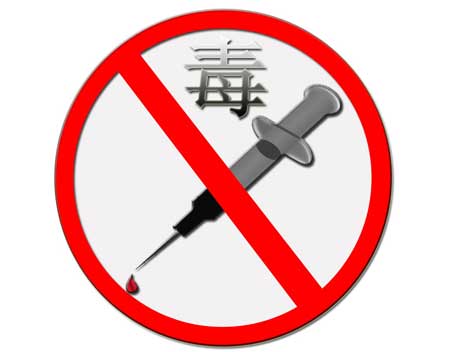
|
Drugs smuggled from abroad, including Southeast Asia and some Central and South Asiancountries, are the main sources of underground drug use across China, according to a senioranti-drug official from the Ministry of Public Security. "Despite great efforts in combating cross-border drug trafficking, we're still facing a grimsituation in the fight against drugs from abroad," Liu Yuejin, director of the ministry's narcoticsdepartment, said in an exclusive interview. Figures from the ministry show more than 90 percent of heroin and methamphetamine tabletsavailable through China's black market come from Southeast Asia. Last year, police in Yunnan province seized 5.37 metric tons of heroin - 73 percent of the totalnationwide - and 8.95 tons of methamphetamine (55 percent of the nationwide total), smuggledover the border with Myanmar. Cases of drug smuggling have also risen sharply on the border between China and Vietnam. Authorities in the Guangxi Zhuang autonomous region uncovered 3,224 cases last year,seizing 415 kg of heroin, up 100 percent from 2011. Liu said China borders two major sources of drugs - the Golden Triangle (comprising parts ofThailand, Laos and Myanmar) and the Golden Crescent, made up of parts of Central andSouth Asia. Opium poppy planting in the Golden Triangle covered about 40,000 hectares last year,producing more than 60 tons of heroin, according to the ministry. Liu said there has been rampant smuggling of synthetic drugs in China from Southeast Asia,including Myanmar, northern Laos and Vietnam, through border areas between Yunnan andGuangxi. Poppy planting in Afghanistan, Pakistan and Iran has reached a total of 154,000 hectares,which can produce more than 370 tons of heroin. "A large quantity of heroin produced in these areas is usually smuggled to the Xinjiang Uygurautonomous region, and transferred to Southeast Asian countries, such as Malaysia andVietnam, and then into Guangdong province by plane ," Liu said. Drugs: Cross-border judicial communication needed Recently, drug traffickers have tried to use shipments of marble, carpets and even Buddhastatuettes to transport drugs as well as more traditional methods, such as the human body,bags or cars, said Yang Zhaohui, another senior official with the ministry's narcoticsdepartment. "Suspects tend to become violent, and even use weapons to fight us at checkpoints," Yangsaid. Cross-border traffickers often use high-tech methods, including wiretapping and networkcontrolling, in remote areas to counter police investigations and avoid punishment, Yang said. "Gang members form a strict management, and assume different tasks, including arrangingdrug sources, hiring traffickers, modifying vehicles, transport and sales," he said. To tackle the problem, China has established judicial cooperation with Southeast Asiancountries, including Myanmar, Laos, Thailand and Malaysia, Liu said. He added that China ispromoting law enforcement cooperation with some countries in Central and South Asia,including Pakistan and Afghanistan. China is also trying to deepen judicial cooperation with North American and European countriesto strengthen intelligence exchanges and case cooperation, Liu said. Hong Daode, a law professor from China University of Political Science and Law, said: "Thepriority is to get the clues and relevant intelligence information for drug trafficking crimes." Liu said the authorities face challenges in combating cross-border drug trafficking, as it isdifficult to uncover trafficking networks and capture gang leaders, as well as conductinginvestigations and collecting evidence. "We need to cooperate with judicial authorities in other countries to identify foreign suspects,and liaise on evidence-collecting abroad," he said.
(China Daily) |
近日,公安部禁毒局局長(zhǎng)劉躍進(jìn)在接受《中國(guó)日?qǐng)?bào)》獨(dú)家專(zhuān)訪(fǎng)時(shí)表示,來(lái)自于“金三角”和“金新月”等境外的毒品仍是我國(guó)地下毒品消費(fèi)市場(chǎng)的主要來(lái)源。 “盡管我們?cè)诖驌艨鐕?guó)毒品犯罪上取得了顯著成效,但受?chē)?guó)際毒情發(fā)展的綜合影響,我們面臨的毒品形勢(shì)仍然十分嚴(yán)峻、復(fù)雜,”他說(shuō)。 據(jù)公安部禁毒局提供的官方數(shù)據(jù)顯示,2012年,我國(guó)國(guó)內(nèi)地下毒品消費(fèi)市場(chǎng)90%以上的海洛因和90%以上的冰毒片劑都源于“金三角”地區(qū)。2012年,僅云南就繳獲緬北海洛因5.37噸、冰毒片劑8.95噸,分別占全國(guó)總量的73.7%和55.6%。 與此同時(shí),中越邊境毒品走私活動(dòng)加劇,去年廣西在中越邊境查獲毒品走私案件3224起,同比翻了一番,繳獲海洛因415千克。 劉躍進(jìn)說(shuō),我國(guó)毗鄰世界兩大毒源地-“金三角”和“金新月”,2012年,“金三角”地區(qū)的罌粟種植面積達(dá)60萬(wàn)畝,可生產(chǎn)海洛因60多噸。 “‘金三角’地區(qū)的合成毒品走私問(wèn)題也愈演愈烈,主要通過(guò)云南、廣西等地向我國(guó)走私活動(dòng)猖獗,”他說(shuō)。 據(jù)他介紹,“金新月”地區(qū)的罌粟種植面積達(dá)231萬(wàn)畝,可生產(chǎn)海洛因370多噸。“該地區(qū)海洛因通過(guò)馬來(lái)西亞、越南等東南亞國(guó)家,經(jīng)航空向廣東等地‘點(diǎn)對(duì)點(diǎn)’滲透,經(jīng)陸路從廣西入境,渠道增多,規(guī)模增大,危害加重。” 劉躍進(jìn)說(shuō),近來(lái)跨境販毒案件呈現(xiàn)一些新的特點(diǎn),藏毒方式不斷翻新。販毒分子在運(yùn)輸毒品過(guò)程中除了常見(jiàn)的人體藏毒、箱包藏毒、汽車(chē)藏毒、貨物夾藏等手段外,還想方設(shè)法利用大理石藏毒、地毯藏毒、佛像藏毒等多種方式夾藏運(yùn)輸毒品。 并且,境外毒品通過(guò)海陸空郵多渠道向我國(guó)進(jìn)行立體滲透。特別是近年來(lái),境外毒販雇傭馬仔采用人體藏毒方式,直接從境外乘坐飛機(jī)點(diǎn)對(duì)點(diǎn)對(duì)我國(guó)進(jìn)行毒品販運(yùn)活動(dòng),躲避我國(guó)設(shè)立的堵源截流網(wǎng)絡(luò)。同時(shí),跨國(guó)販毒團(tuán)伙還利用當(dāng)前日益發(fā)展的物流快遞渠道,將毒品從境外“點(diǎn)對(duì)點(diǎn)”地販運(yùn)至內(nèi)地城市,大大增加了對(duì)毒品堵截的壓力。 他說(shuō),在跨國(guó)販毒案件中,毒販武裝對(duì)抗性強(qiáng),暴力抗法現(xiàn)象屢屢出現(xiàn),持槍拒捕、武裝對(duì)抗查緝的案件時(shí)有發(fā)生。據(jù)公安部禁毒局提供的數(shù)據(jù)顯示,自1月份以來(lái),各地在破獲毒品案件中共收繳各類(lèi)槍支739支,子彈2.9萬(wàn)發(fā)。 再有,他說(shuō),跨國(guó)販毒團(tuán)伙在實(shí)施犯罪活動(dòng)過(guò)程中,不斷采用竊聽(tīng)、定位、網(wǎng)絡(luò)遙控等多種高科技手段進(jìn)行反偵察,逃避打擊,使公安機(jī)關(guān)查緝毒品的難度不斷加大。 “跨國(guó)販毒團(tuán)伙組織內(nèi)部分工明確,聯(lián)系上家,組織貨源、雇傭馬仔、改裝車(chē)輛、運(yùn)輸毒品、銷(xiāo)售毒品等各個(gè)環(huán)節(jié)均有專(zhuān)人負(fù)責(zé),具有很強(qiáng)的反偵察能力,”他說(shuō)。 劉躍進(jìn)說(shuō),為了應(yīng)對(duì)國(guó)際毒情帶來(lái)的新情況和打擊猖獗的毒品跨境走私問(wèn)題,中國(guó)積極參與國(guó)際禁毒執(zhí)法合作,特別是充分利用聯(lián)合國(guó)、東亞次區(qū)域以及上海合作組織等多邊平臺(tái),在共同打擊跨境毒品犯罪案件方面、深化國(guó)際和區(qū)域禁毒執(zhí)法合作,取得了顯著效果。 我國(guó)積極鞏固和發(fā)展與老撾、緬甸、越南、泰國(guó)、柬埔寨、印尼、馬來(lái)西亞等東南亞國(guó)家的雙邊合作,穩(wěn)步推進(jìn)與俄羅斯及吉爾吉斯斯坦、哈薩克斯坦和塔吉克斯坦、阿富汗、巴基斯坦等中亞、南亞有關(guān)國(guó)家的合作。 同時(shí),努力深化與美國(guó)、加拿大、德國(guó)、英國(guó)、澳大利亞等有關(guān)重點(diǎn)國(guó)家的禁毒情報(bào)交流和個(gè)案合作,與相關(guān)國(guó)家聯(lián)合偵辦多起特大跨國(guó)走私販毒案件,提高了跨國(guó)跨地區(qū)執(zhí)法合作能力,他說(shuō)。 為了有效整治湄公河流域突出的毒品犯罪問(wèn)題,從今年4月20日至6月20日,中國(guó)、老撾、緬甸和泰國(guó)等四國(guó)執(zhí)法部門(mén)集中開(kāi)展湄公河流域“平安航道”聯(lián)合掃毒行動(dòng),以該流域主要販運(yùn)通道為重點(diǎn),堵截查控毒品和易制毒化學(xué)品,摧毀“金三角”毒品在該流域的運(yùn)輸網(wǎng)絡(luò),遏制毒品和易制毒化學(xué)品走私販運(yùn)。 行動(dòng)啟動(dòng)至今,四國(guó)警方共同破獲了一批有影響的跨國(guó)、跨區(qū)域毒品大案要案,摧毀了一批跨國(guó)制販毒網(wǎng)絡(luò)和制毒工廠(chǎng),抓獲了一批組織者、策劃者和制毒技師,通過(guò)倒查來(lái)源,堵截易制毒化學(xué)品流入緬北,切斷制毒產(chǎn)業(yè)鏈,進(jìn)一步遏制了“金三角”地區(qū)毒品來(lái)源。 在本次行動(dòng)中,中國(guó)和老撾警方于3月19日聯(lián)合偵破了一起在湄公河水域販運(yùn)毒品的特大跨國(guó)走私毒品案件,當(dāng)場(chǎng)從該船甲板夾層內(nèi)查獲冰毒579.7千克,抓獲了涉案的5名跨國(guó)販毒犯罪嫌疑人。 劉躍進(jìn)說(shuō)道,跨境販毒案件也給公安機(jī)關(guān)的偵查和打擊帶來(lái)諸多挑戰(zhàn)和現(xiàn)實(shí)困難。一方面,跨境販毒網(wǎng)絡(luò)發(fā)現(xiàn)難和幕后組織者抓捕難。跨境販毒案件的幕后組織者一般都身處境外遙控指揮,受?chē)?guó)家間的不同司法體制和國(guó)家間引渡、移交等條件制約,實(shí)際認(rèn)定、追蹤、抓捕及移交幕后毒梟的周期較長(zhǎng),難度較大。 另一方面,打擊跨境毒品犯罪取證難。在打擊跨境毒品犯罪時(shí),對(duì)外籍犯罪嫌疑人的身份確認(rèn),對(duì)涉及境外的毒品犯罪行為證據(jù)收集與固定,都需要相關(guān)國(guó)家警方的協(xié)作與配合,由于相關(guān)國(guó)家間的司法體制不同,法庭證據(jù)要求不同,打擊跨境毒品的取證難度相對(duì)較大。 (中國(guó)日?qǐng)?bào)記者張琰編譯)
|
|
|
